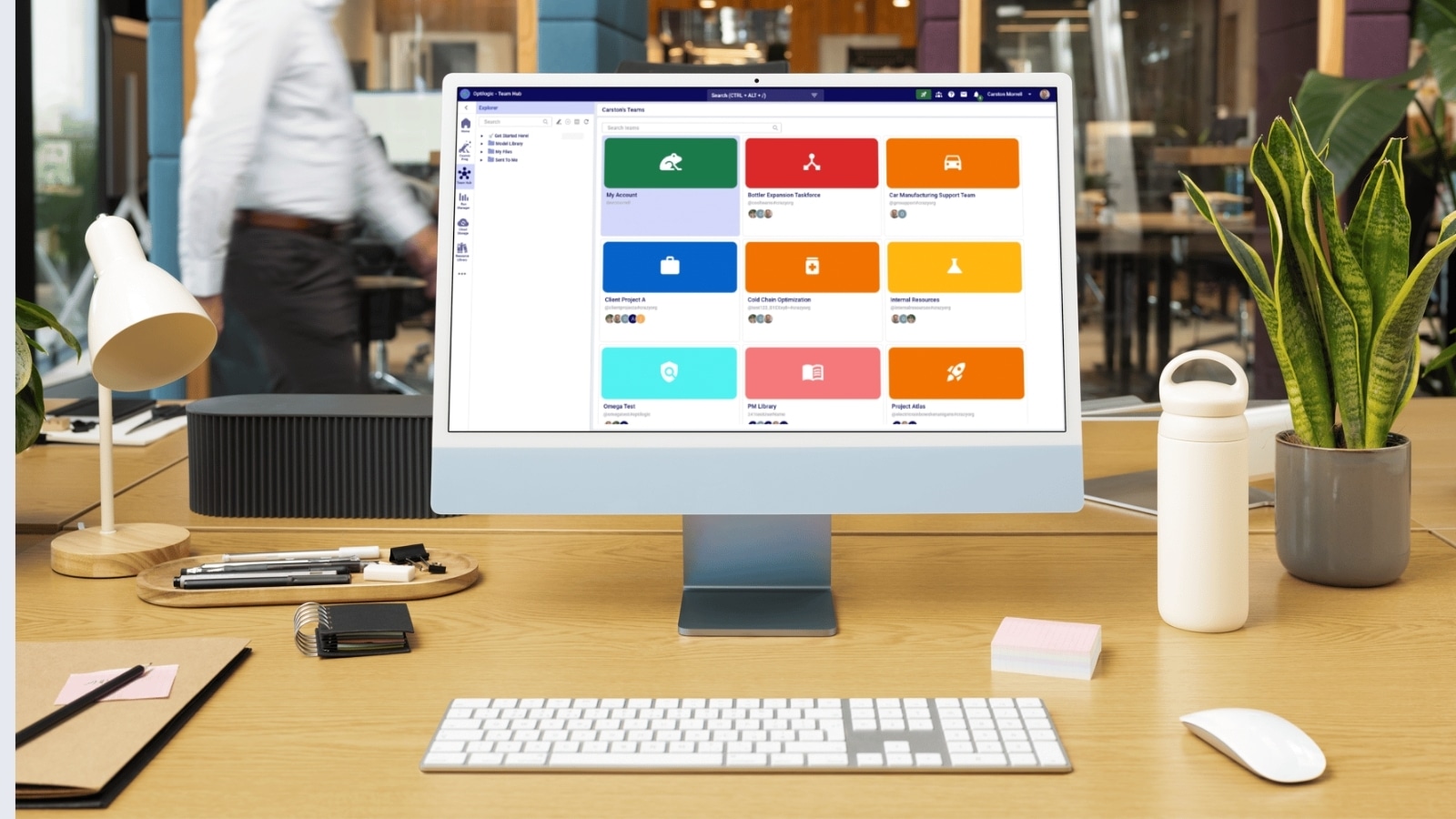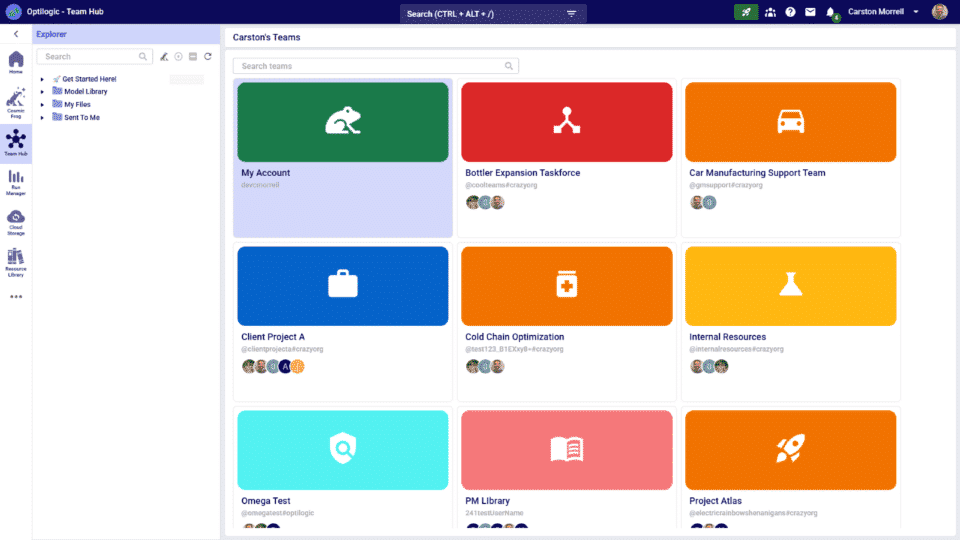
Optilogic launches Enterprise Teams—real-time, cross-functional supply chain collaboration with shared workspaces, instant model updates, and centralized visibility.
Published by
Published on
July 15, 2025





[ANN ARBOR, July 15, 2025] – Optilogic, a supply chain design software innovator, today announced the launch of Enterprise Teams, a new feature set that enables real-time, cross-functional collaboration across shared workspaces. Available now in the Optilogic platform, Enterprise Teams gives users a centralized view of models and files, with synchronized updates and team-level visibility, so supply chain organizations and consultants can work faster, stay aligned, and eliminate version mismatches.
Today’s supply chain design teams are distributed, fast-moving, and increasingly cross-functional. But most modeling platforms haven’t kept up. Collaboration still relies on disconnected files, manual updates, and unclear ownership. Enterprise Teams is Optilogic’s answer: a purpose-built collaboration layer that gives teams a single source of truth, eliminating data silos, version mismatches, and inefficient handoffs across users, departments, and client projects.
“Enterprise Teams is a response to how companies actually work—globalized, collaborative, and under pressure to take action quickly and accurately,” said Rebecca Janowiak, VP of Product Management at Optilogic. “We’re giving teams a seamless way to work on the same models in real time, without version issues or visibility gaps slowing them down. This feature helps teams make decisions faster, with better alignment, and fewer surprises. What’s more – commercial grade admin features enable organizations to better manage team members and work content seamlessly and securely. No other supply chain modeling solution has this.”
Enterprise Teams includes a set of core tools designed to streamline collaboration, maintain consistency, and give teams clear visibility into shared work. Any updates made within a team workspace reflect instantly for all members, reducing confusion and eliminating administrative overhead.
Key capabilities include:
“Optilogic’s Enterprise Teams feature exceeded my expectations and is very well thought out,” said the Digital Platform Leader at a major global retailer. “Optilogic’s product roadmap and pace of development are impressive, and we are excited about our partnership.”
“For companies like ours working across partners, Enterprise Teams enables efficient collaboration and scalable delivery. It’s a powerful enabler of democratized supply chain design,” added Minoru Muragi, Co-Founder & CEO at BigM, Inc.
Enterprise Teams supports a wide range of organizational structures, making it easier for companies to collaborate across regions, functions, and clients. With intelligent content switching and shared context, users can move between teams while ensuring the right people always have access to the right data.
Common use cases include:
Enterprise Teams builds on Optilogic’s ongoing investment in secure, scalable collaboration across its platform. Future enhancements will include user-level permissions, admin-defined compute and storage limits, platform-wide announcements, and deeper analytics for team and organizational visibility.
Enterprise Teams is now available to all professional users of the Optilogic platform. To learn more or request a walkthrough, visit www.Optilogic.com or watch the feature overview video here.

Optilogic is a supply chain design software company that enables companies to build virtual supply chain models which allow them to answer any supply chain question and safely test and implement supply chain changes—big and small. Our Cosmic Frog solution empowers analysts to test how future supply chain changes would perform in terms of cost, service, and risk, and business users can answer role-specific questions with no specialized training required. Stay in touch with Optilogic on LinkedIn, Twitter, Facebook, and YouTube and visit www.Optilogic.com.
[ANN ARBOR, July 15, 2025] – Optilogic, a supply chain design software innovator, today announced the launch of Enterprise Teams, a new feature set that enables real-time, cross-functional collaboration across shared workspaces. Available now in the Optilogic platform, Enterprise Teams gives users a centralized view of models and files, with synchronized updates and team-level visibility, so supply chain organizations and consultants can work faster, stay aligned, and eliminate version mismatches.
Today’s supply chain design teams are distributed, fast-moving, and increasingly cross-functional. But most modeling platforms haven’t kept up. Collaboration still relies on disconnected files, manual updates, and unclear ownership. Enterprise Teams is Optilogic’s answer: a purpose-built collaboration layer that gives teams a single source of truth, eliminating data silos, version mismatches, and inefficient handoffs across users, departments, and client projects.
“Enterprise Teams is a response to how companies actually work—globalized, collaborative, and under pressure to take action quickly and accurately,” said Rebecca Janowiak, VP of Product Management at Optilogic. “We’re giving teams a seamless way to work on the same models in real time, without version issues or visibility gaps slowing them down. This feature helps teams make decisions faster, with better alignment, and fewer surprises. What’s more – commercial grade admin features enable organizations to better manage team members and work content seamlessly and securely. No other supply chain modeling solution has this.”
Enterprise Teams includes a set of core tools designed to streamline collaboration, maintain consistency, and give teams clear visibility into shared work. Any updates made within a team workspace reflect instantly for all members, reducing confusion and eliminating administrative overhead.
Key capabilities include:
“Optilogic’s Enterprise Teams feature exceeded my expectations and is very well thought out,” said the Digital Platform Leader at a major global retailer. “Optilogic’s product roadmap and pace of development are impressive, and we are excited about our partnership.”
“For companies like ours working across partners, Enterprise Teams enables efficient collaboration and scalable delivery. It’s a powerful enabler of democratized supply chain design,” added Minoru Muragi, Co-Founder & CEO at BigM, Inc.
Enterprise Teams supports a wide range of organizational structures, making it easier for companies to collaborate across regions, functions, and clients. With intelligent content switching and shared context, users can move between teams while ensuring the right people always have access to the right data.
Common use cases include:
Enterprise Teams builds on Optilogic’s ongoing investment in secure, scalable collaboration across its platform. Future enhancements will include user-level permissions, admin-defined compute and storage limits, platform-wide announcements, and deeper analytics for team and organizational visibility.
Enterprise Teams is now available to all professional users of the Optilogic platform. To learn more or request a walkthrough, visit www.Optilogic.com or watch the feature overview video here.

Optilogic is a supply chain design software company that enables companies to build virtual supply chain models which allow them to answer any supply chain question and safely test and implement supply chain changes—big and small. Our Cosmic Frog solution empowers analysts to test how future supply chain changes would perform in terms of cost, service, and risk, and business users can answer role-specific questions with no specialized training required. Stay in touch with Optilogic on LinkedIn, Twitter, Facebook, and YouTube and visit www.Optilogic.com.
Fill out the form to unlock the full content

.png)

.png)